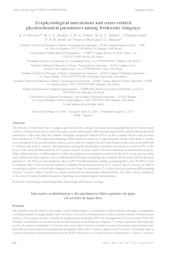Ecophysiological interactions and water-related physicochemical parameters among freshwater stingrays.
Ecophysiological interactions and water-related physicochemical parameters among freshwater stingrays.
Author(s): OLIVEIRA, A. T.; ARAÚJO, M. L. G.; LEMOS. J. R. G.; SANTOS, M. Q. C.; PANTOJA-LIMA, J.; ARIDE, P. H. R.; TAVARES-DIAS, M.; MARCON, J. L.
Summary: The objective of this study was to compare and correlate the ecology of neonates and young individuals of Potamotrygon wallacei, Potamotrygon motoro and Paratrygon aiereba with regard to their hematological profile and the physicochemical parameters of the water that they inhabit. Principal component analysis (PCA) on the complete blood count revealed total variation of 72.92%, thus demonstrating a differentiation system for oxygen demand. On the other hand, P. motoro was considered to be an intermediate species, given that its complete blood count characteristics interacted with both P. wallacei and with P. aiereba. The interaction among the biochemical variables was shown to total 64.67% of the factors. This allowed differentiation of P. wallacei from P. aiereba, while P. motoro maintained an intermediate position. These characteristics of differentiation within the preferred environment corroborate the PCA of the present study and confirm that these species can be differentiated through considering the complete blood count and biochemical parameters. The PCA on water properties showed 68.57% differentiation, mainly comprising the x axis (49.44%). It can be affirmed that P. motoro has the capacity to inhabit the preferential areas of P. wallacei and P. aiereba, as well as occupying localities in which other stingrays are not found. In conclusion, P. wallacei presents patterns differentiating it from P. aiereba, while P. motoro is a species that presents intermediate characteristics. The latter can be considered to be a more broadly distributed species regarding its ecophysiological characteristics.
Publication year: 2017
Types of publication: Journal article
Unit: Embrapa Amapá
Keywords: Arraia, Ecologia animal, Fisiologia, Hematologia, Hematology, Potamotrygonids, animal ecology, physiology
Observation
Some of Embrapa's publications are published as ePub files. To read them, use or download one of the following free software options to your computer or mobile device. Android: Google Play Books; IOS: iBooks; Windows and Linux: Calibre.
Access other publications
Access the Agricultural Research Database (BDPA) to consult Embrapa's full library collection and records.
Visit Embrapa Bookstore to purchase books and other publications sold by Embrapa.

